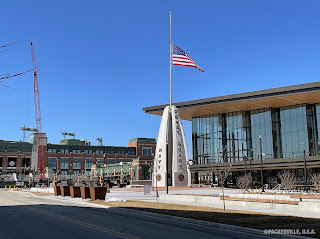While heading over to the training camp practice field, I noticed that this building on the south end of Clarke Hinkle Field (along Mike McCarthy Way) has some interesting (and plentiful) vents and pipes on the roof. A quick check of Google Maps shows that they weren’t always there, and by their shininess, are most likely new. Hmmm... what is contained therein?
I was heading in this direction because I noticed while walking on Oneida Street that work has been progressing on the resurfacing of Ray Nitschke Field — where the Packers spend Training Camp each summer. This view is through the open gate outside of the Green Bay Packers Turf Department.
The old practice field is being replaced to match the SIS Grass playing surface in Lambeau Field. The Packers don’t miss any chances to help the team’s performance in NFL games. If you’re going to play on it, why not practice on it?
When you’re used to seeing this view with lush green grass, seeing it consisting only of pea gravel at this point gets your attention.There is quite a bit of work to do yet, as even the existing gravel has not been worked into a level surface yet.
Partially-buried pipes that are perhaps part of the sprinkler system, or perhaps the drainage system.
A view of the field with the grandstands that will hopefully be filled with fans this August. That would include me and my group of friends who meet there for practice each and every time the Packers are scheduled to practice.
A view of the field, looking toward The Don Hutson Center.
This water access plate shows just how far down things are taken when installing new turf. The top of the concrete is at field level, so as to not be a tripping hazard.
For the unfamiliar, the Training Camp field is Ray Nitschke Field, on the east (or back) side of The Don Hutson Center.
The gates though which I long so badly to enter later this summer.
We are now looking at the field from the north end (along Armed Forces Drive).
There are various types of equipment in use to install the new field.
Only a few workers were on hand late on a Friday afternoon.
Looking all the way down the field toward where I was standing and seeing the pea gravel.
Still quite a bit of work to finish on the north end before moving to the next step in the field installation process.
The tall black poles at left are described in our last installment of Offseason Updates. Since then, the workers have completed the concrete work around their bases and along the north fence line.
I resisted the urge to enter the fence gate opening and take a closer look at things.
A view of the new Resch Expo and Lambeau Field beyond that, walking west on Armed Forces Drive.
I had to stand on my tippy-toes to get a shot of Clarke Hinkle Field (the fences remain covered), where you can see the wear and tear from 2020’s in-season practices.
And now, for more in-depth coverage of the relocation of a 400,000-gallon wastewater surge tank at the easternmost edge of stadium property, along Oneida Street. We’re pretty sure this is the only place on the internet that you’ll see what we present here.
Above and below, various views of the project, taken through small holes in the construction fence, which is covered by a photographer-annoying green mesh fabric. But we get the shots we need anyway.
Now we’re inside Lambeau Field’s Atrium, which has been turned into a Bellin Health COVID-19 vaccination center. Below are some shots of the set-up. According to the press release: “The Lambeau Field vaccination clinic initially will operate in the Atrium and may expand to other areas of the stadium as supply and weather allow, said Bellin Health President and CEO Chris Woleske. With adequate supply, the site will have capacity to vaccinate 6,000 individuals per week initially and quickly ramp up to 10,000 individuals weekly.”
And lastly, we see some last vestiges of winter hanging on in the Lambeau Field parking lot. But, if you’ve lived in the midwest, you know that there’s always that possible April blizzard waiting just around the corner.
























































